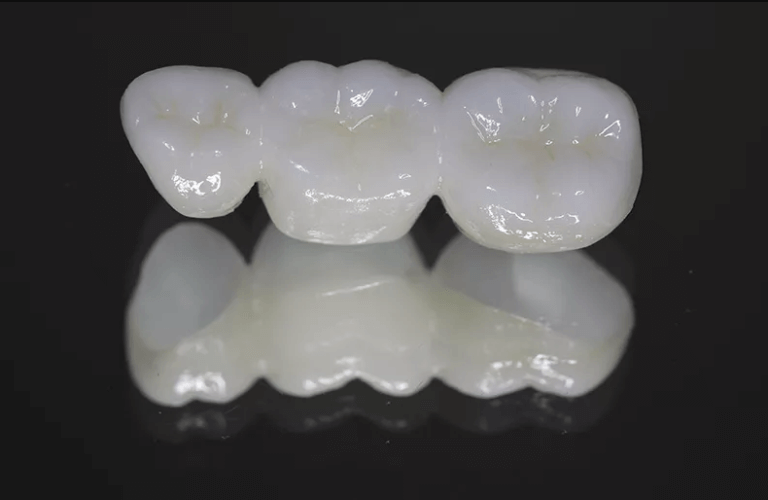Loose Dental Bridge
What Is A Loose Dental Bridge?
A loose dental bridge is a common concern among dental patients, often causing discomfort and raising questions about how to manage the issue until professional help is available. Dental bridges are durable prosthetics that “bridge” the gap left by missing teeth, typically anchored to natural teeth on either side of the gap, known as abutment teeth. However, these bridges can sometimes become loose, impacting comfort, function, and oral health.
Before you contact a Toronto dentist to examine a Loose Dental Bridge, there are some things you should know as a patient:
- Why Do Dental Bridges Become Loose?
- Signs And Symptoms Of A Loose Dental Bridge
- Treatment Options For A Loose Dental Bridge
- Managing A Loose Dental Bridge Until You Can See The Dentist
- Frequently Asked Questions About Loose Dental Bridges
If you have questions about Loose Dental Bridge or other dental problems, please contact us for more information.
Why Do Dental Bridges Become Loose?
There are several reasons a dental bridge might become loose:
- Tooth Decay: Decay in the abutment teeth can weaken the bond between the bridge and the teeth, causing the bridge to loosen.
- Trauma or Injury: Physical trauma to the face or mouth can dislodge or loosen a dental bridge.
- Misaligned Bite or Bruxism: A misaligned bite or teeth grinding (bruxism) can place excessive pressure on the bridge, compromising its stability.
- Aging Dental Cement: Over time, the cement used to bond the bridge may degrade, reducing its effectiveness.
- Poor Oral Hygiene: Insufficient oral hygiene can allow bacterial buildup, which can weaken the bridge bond and affect surrounding teeth.
Understanding the underlying cause of a loose dental bridge is crucial for determining the right treatment. Addressing these factors early can help maintain the stability of your bridge and prevent further dental complications. If you have further questions about a Loose Dental Bridge, please contact us.
Signs And Symptoms Of A Loose Dental Bridge
If you have a loose dental bridge, you might notice one or more of these symptoms:
- Sensitivity: Pain or sensitivity when consuming hot, cold, or sweet foods and beverages.
- Movement or Wobbliness: A noticeable shifting or wobbling of the bridge when touched.
- Misaligned Bite: Changes in the way your teeth meet when you bite down.
- Discomfort: Pain or discomfort when chewing or closing your mouth.
- Bad Odor or Taste: Foul taste or smell, which may indicate bacterial buildup under the bridge.
- Visible Damage: Chips, cracks, or other visible wear on the bridge.
If you experience any of these symptoms, it’s important to contact a dentist for an evaluation as soon as possible. If you have further questions about a Loose Dental Bridge, please contact us.
Treatment Options For A Loose Dental Bridge
Depending on the severity of the looseness and the underlying cause, there are several treatment options:
- Recementation: If the bridge is intact, the dentist may clean and reapply dental cement to secure the bridge.
- Bridge Replacement: A damaged bridge may need to be replaced with a new one, which involves preparing the teeth and placing a new prosthetic.
- Root Canal Therapy: If decay or infection has affected the abutment teeth, root canal therapy may be necessary before placing a new bridge.
- Tooth Extraction and Alternative Replacement: In cases where the abutment tooth cannot be saved, an extraction may be required, with options for a replacement bridge or dental implant.
The choice of treatment depends on your specific circumstances and should be discussed with your dentist to ensure the best outcome for long-term oral health. If you have further questions about treatment options for a Loose Dental Bridge, please contact us.

Managing A Loose Dental Bridge Until You Can See The Dentist
If you notice a loose dental bridge and can’t see a dentist immediately, consider the following temporary steps to manage discomfort:
- Avoid Certain Foods: Stick to soft foods and avoid anything sticky or chewy that could dislodge the bridge further.
- Practice Gentle Oral Care: Continue brushing and flossing gently around the bridge to prevent bacterial buildup.
- Use Temporary Dental Adhesive: Temporary adhesives can help hold the bridge in place, but should only be used as a short-term solution.
- Take Over-the-Counter Pain Relief: If you’re experiencing pain, consider taking ibuprofen or acetaminophen, following the recommended dosage on the package.
These measures can help you manage discomfort temporarily, but be sure to schedule a dental visit as soon as possible for a permanent solution. If you have further questions about a Loose Dental Bridge, please contact us.
Frequently Asked Questions About Loose Dental Bridges
- Can I re-cement a loose dental bridge at home?
While over-the-counter dental adhesives can provide a temporary fix, it’s essential to see a dentist for professional recementation to avoid complications.
- How long should a dental bridge last?
With proper care, a dental bridge can last anywhere from 10 to 15 years or longer.
- Is a loose dental bridge a dental emergency?
A loose dental bridge should be evaluated promptly to avoid further damage, but it may not require immediate emergency care unless you’re experiencing severe pain or discomfort.
- Will dental insurance cover the repair or replacement of a loose bridge?
Coverage varies by insurance plan. Review your policy or consult with your insurance provider to understand your benefits regarding dental bridge repairs or replacements.
A loose dental bridge is a common issue that can be addressed effectively with timely professional care. For more information on managing a loose dental bridge or other dental concerns, contact us at Atlas Dental. Our team is here to help ensure you receive the care you need for a healthy, comfortable smile.

